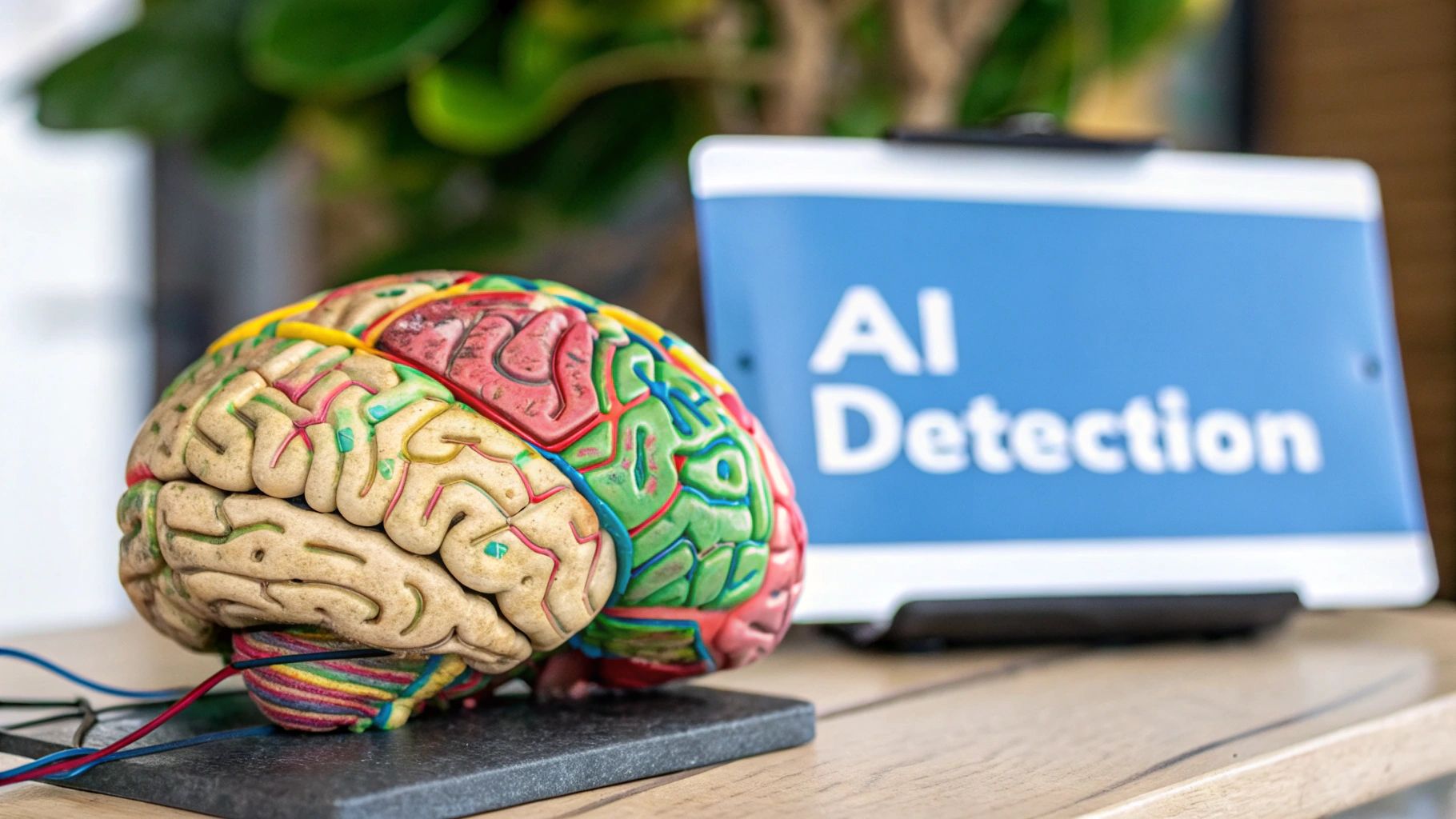Artificial Intelligence Detection: A Comprehensive Guide for Modern Organizations
The Evolution of AI Detection in Education

As AI tools become more common in education, schools and universities face new challenges in maintaining academic integrity while embracing useful technology. Students and educators need clear guidelines for appropriate AI use, backed by reliable detection methods that can identify AI-generated work. This balance helps ensure students develop critical thinking skills through original work while still benefiting from AI as a learning tool.
The Rise of AI Detection Tools
Leading universities have made significant progress in identifying AI-generated content, with some reporting a 47% improvement in detection rates. This success stems from better natural language processing capabilities that can spot subtle patterns unique to AI writing. As detection methods improve, schools can more effectively uphold academic standards while teaching students about responsible AI use. Clear policies and detection tools give faculty confidence in evaluating student work.
Balancing Innovation with Authenticity
The key is finding ways to use AI productively in education while preserving academic integrity. Detection tools serve an important role – not to restrict technology use, but to verify that students are learning and growing through their own efforts. This approach creates an environment where students can explore AI capabilities while understanding the importance of original thinking and ethical academic conduct.
Practical Implementation and Strategies
Many universities now use comprehensive approaches combining technology and teaching methods. Some integrate AI detection directly into their learning platforms to automatically screen submissions. Check out our guide on how to master content checking. Faculty also receive training on identifying AI-written text and having productive discussions with students about appropriate AI use. This multi-layered strategy addresses AI content proactively through both tools and education.
Addressing Challenges and Future Directions
While detection capabilities have improved significantly, some challenges remain. False positives, where human writing is incorrectly flagged as AI-generated, require careful review processes. Detection methods must also keep pace as AI writing tools grow more advanced. Looking ahead, universities will likely adopt integrated approaches that combine multiple detection techniques with analysis of writing style and structure. This ongoing development of detection practices helps maintain academic standards as AI continues to evolve.
Breaking Down Technical Barriers

AI detection systems in education face several key technical challenges that affect their reliability. Understanding these limitations is essential for developing better solutions. Let's examine why even advanced systems sometimes have trouble correctly identifying AI-generated content.
Current Limitations in AI Detection
One major hurdle is the difficulty in telling human and AI writing apart. Modern language models can create text that closely mirrors human writing patterns, making detection increasingly complex. For example, when AI tools generate text, the word patterns and sentence structures often appear remarkably natural. This similarity means some detection tools achieve only around 50% accuracy – no better than random chance. The challenge becomes even harder when content is run through paraphrasing tools, which can mask telltale signs of AI generation.
Overcoming Detection Challenges With a Multi-Pronged Approach
The field continues to advance as researchers develop new detection methods. One effective strategy analyzes entire documents rather than individual sentences, revealing patterns that become apparent only when examining longer text samples. For instance, by looking at how ideas connect across paragraphs, detectors can better spot the differences between human and AI writing styles.
Combining different detection approaches also improves accuracy significantly. Some systems now use a mix of statistical analysis, linguistic examination, and metadata review. This is similar to how criminal investigators build cases using multiple types of evidence – the combination of different detection methods creates a more complete picture of whether content is human or AI-generated.
The Role of Pattern Recognition and Validation
Advanced pattern recognition is helping detection systems spot subtle signs of AI writing. New algorithms can identify specific sentence structures, word relationships, and writing quirks that often appear in machine-generated text. Just as facial recognition software maps unique features to identify individuals, these systems look for characteristic patterns that suggest AI involvement. The field is also making progress with validation techniques that verify content origins. By tracking where text comes from and how it was created, these methods make it harder to pass off AI writing as original human work. As detection technology improves, this combination of pattern analysis and source validation will become increasingly important for maintaining academic integrity.
Building More Reliable Detection Systems
As AI writing becomes more advanced, the methods we use to detect it must evolve beyond basic pattern matching. We need smarter, more sophisticated approaches that can identify AI-generated text with greater accuracy. Let's explore the key strategies and frameworks that make detection more effective.
Combining Human Expertise and AI Capabilities
The most successful detection methods blend human judgment with AI analysis tools. While AI can process large amounts of text data to spot patterns, human experts provide crucial context and interpretation. Think of it like detective work – AI tools gather evidence like fingerprints and DNA, but human investigators connect the dots to solve the case. For example, teachers can use AI detection software to flag suspicious content while applying their knowledge of student writing styles to confirm or dismiss concerns.
Advanced Detection Strategies in Action
Modern detection systems use multiple techniques working together. They examine text for telltale patterns in sentence structure, word choice, and punctuation habits that often distinguish AI writing from human work. The analysis goes deeper than plagiarism checking by studying how ideas flow and connect. For instance, if a piece lacks logical progression or jumps randomly between topics, it may signal AI generation. When combined with expert review, these multi-layered approaches provide more reliable results.
Practical Frameworks for Implementation
To effectively use advanced detection strategies, organizations need clear processes and guidelines. Here's a practical framework to consider:
- Establish Clear Policies: Create specific rules about acceptable AI use and consequences for misuse
- Train Staff: Help teachers and administrators understand how to use detection tools and evaluate results
- Integrate Tools: Build detection seamlessly into existing systems like course management platforms
- Review and Validate: Have qualified staff review flagged content to minimize false positives
This structured approach helps organizations detect AI content more accurately while being fair to students. The need for careful, nuanced detection is clear – for example, Turnitin data shows that only a small percentage of assignments are mostly AI-generated. By focusing on building thorough detection processes now, schools and organizations can better address this challenge as AI writing continues to advance.
Implementing Detection Strategies That Scale

After establishing reliable AI detection capabilities, organizations face the challenge of integrating these tools effectively across their operations. The key is incorporating detection seamlessly into existing workflows without creating bottlenecks. Consider a university setting where essay submissions automatically go through AI screening, providing instant feedback to both students and faculty. This natural integration makes AI detection a standard part of the process while promoting responsible use.
Staff Training and System Integration
Success depends heavily on proper training and smooth technical integration. Faculty and administrators need more than just operational knowledge of AI detection tools – they must understand how to interpret results accurately and handle potential issues with students effectively. This includes recognizing AI text patterns, dealing with false positives, and having constructive discussions about academic integrity. The tools should also work smoothly with existing platforms like learning management systems and plagiarism checkers. For example, when content gets flagged, it can automatically route to the right instructor for review, making the process efficient and manageable.
Monitoring Performance and Ensuring Accuracy
Installing detection tools is just the beginning – continuous monitoring and accuracy checks are essential. Organizations should track key metrics like detection rates, false positive frequency, and user feedback. High false positive rates can undermine confidence in the system and create extra work for instructors. Regular metric reviews allow for fine-tuning detection approaches as AI writing technology advances. Adding user feedback channels helps identify issues early and guides improvements. This ongoing refinement maintains detection quality and user satisfaction. Find more insights in our article about how to master paraphrasing.
Practical Examples of Scalable Implementation
Many organizations have successfully scaled AI detection across their operations. Several universities have built detection directly into submission systems, achieving 85% accuracy while maintaining efficient workflows. These schools also provide comprehensive faculty training programs to support effective tool use and proactive academic integrity efforts. In publishing, some companies use detection to verify manuscript originality, protecting intellectual property and publication quality. These real examples show that with proper planning around technology, training, and monitoring, organizations can implement AI detection successfully at scale to uphold high standards.
Navigating Ethical Considerations
AI detection technology is playing an increasingly important role in content verification, but its use comes with significant ethical implications. As more organizations adopt these tools, they must carefully weigh accuracy requirements against core principles of privacy and fairness. Getting this balance right is essential for building and maintaining public trust.
Balancing Detection Accuracy with User Privacy
The central challenge in AI detection lies in finding the right equilibrium between effectiveness and privacy protection. While identifying AI-generated content serves an important purpose, it shouldn't require excessive data collection or analysis that infringes on individual privacy rights. Organizations need to embrace data minimization – gathering only what's truly needed for detection – and implement robust security measures to prevent misuse. This focused approach helps realize the benefits of detection while safeguarding personal information. You might be interested in: How to master grammar checking.
Ensuring Transparency and Fairness in AI Detection
Clear communication about how AI detection systems work is vital for building trust. Users deserve to understand the criteria used to evaluate content and flag potential AI generation. When detection methods are opaque, it can breed suspicion and raise valid concerns about bias. For example, if certain writing styles or demographic groups face disproportionate flagging, it risks perpetuating inequities. Organizations should prioritize explainable AI approaches that help users understand detection decisions and provide clear paths for appeals when needed. Regular audits using diverse test data can help catch and correct potential biases before they cause harm.
Developing Responsible Usage Policies and Guidelines
Strong policies must complement the technical systems. Clear guidelines should spell out appropriate and inappropriate uses of AI-generated content in specific contexts. In education, this might mean allowing AI tools for brainstorming but not for submitting work as original. Publishing contexts require clarity on using AI for research versus claiming AI-written content as human-authored. Well-designed policies give users a framework for ethical conduct while establishing fair processes for handling flagged content, including appeals and consequences for violations.
Learning from Real-World Examples
Many organizations are finding effective ways to implement ethical AI detection. Some universities pair detection tools with student education about responsible AI use – an approach that upholds academic standards while supporting learning. Similarly, some media companies use detection to maintain content quality while being fully transparent with writers about their processes. These examples show how organizations can effectively use AI detection while staying true to ethical principles. Their experiences offer valuable lessons for others working to develop responsible practices that build trust and promote fairness.
Preparing for Future Developments

As AI technology continues to advance, the methods for detecting AI-generated content must also grow and adapt. Organizations need to take a proactive stance to ensure their detection capabilities remain effective against increasingly sophisticated AI systems. Understanding current trends and preparing for emerging challenges is essential for staying ahead of developments in this rapidly changing field.
Adapting to Evolving AI Models
Current AI detection tools face growing challenges as AI writing becomes more nuanced and human-like. One key issue is the difficulty in identifying content that has been carefully paraphrased or edited after initial AI generation. Simple pattern matching is no longer sufficient – detection systems need to examine deeper aspects like writing style, logical flow, and linguistic patterns. This requires more advanced analysis techniques that can pick up on subtle indicators of machine authorship.
The Rise of Multimodal AI and Detection
A new challenge comes from multimodal AI systems that can generate combinations of text, images, and other media formats. For example, an AI might create a complete presentation with writing, visuals, and formatting. Detecting AI involvement across multiple content types requires analyzing how different elements work together and looking for inconsistencies that might reveal automated creation. Detection tools will need to expand beyond text analysis to handle these mixed-media outputs effectively.
Future-Proofing Your AI Detection Strategy
Organizations can prepare for these changes by investing in detection technology research and development. This includes exploring new approaches like metadata analysis, digital fingerprinting, and advanced machine learning. Working together across institutions is also vital – when researchers, developers, and educators share information about new AI writing patterns and detection methods, it strengthens everyone's ability to identify machine-generated content accurately.
Addressing Ethical Considerations in Future Developments
Beyond the technical aspects, we must carefully consider the ethical implications of AI detection. As detection tools become more powerful, questions about privacy, fairness, and transparency grow more pressing. Organizations should establish clear guidelines for using these tools responsibly, including fair processes for reviewing flagged content and ensuring equal treatment across different user groups. By addressing these ethical concerns early, we can build trust while maintaining effective detection practices.
SmartStudi offers a suite of AI-powered tools designed to empower students in their academic journeys. From AI detection and paraphrasing to essay generation and grammar checking, our platform provides comprehensive support for various academic tasks. Visit us at https://smartstudi.com to explore how SmartStudi can help you succeed.